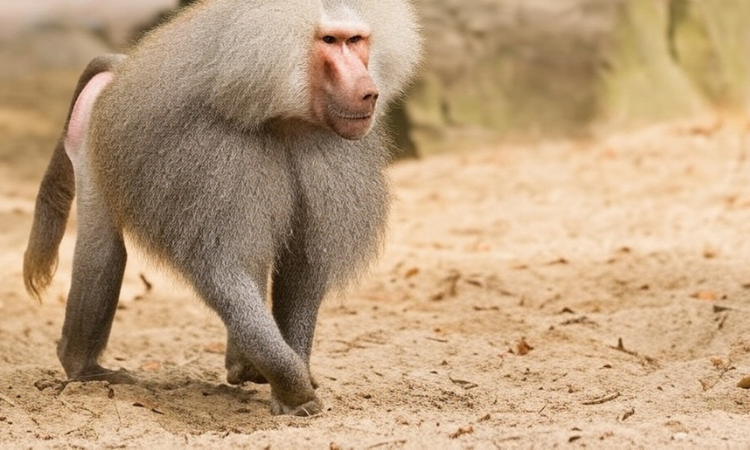Fascinating Facts about 6 Baboon Species You Didn’t Know
Baboon: Discover fascinating baboon facts, including diet, social structure, and vibrant buttocks. Learn about the different baboon species.
Baboons, belonging to the genus Papio in the family Cercopithecidae (Old World monkeys), are not just survivors; they’re social architects, opportunistic foragers, and fierce defenders of their troops.
Often misunderstood as pests or aggressive brutes, these offer profound insights into primate sociality, ecology, and human parallels.
These fascinating primates are among the largest monkeys in the world, with males averaging 33 to 82 pounds (15–37 kg) and bodies 20 to 40 inches (50–100 cm) long, excluding tails that can add another 18–28 inches (45–70 cm).
They’re terrestrial powerhouses, yet agile climbers, thriving in Africa’s diverse landscapes. With six baboon species scattered across sub-Saharan Africa and into Arabia, they exhibit remarkable flexibility. Let’s dive in.
Taxonomy and Evolutionary History of a Baboon
They trace their lineage to the Miocene epoch, around 23–5 million years ago, when early cercopithecoids diverged into Old World monkeys.
Fossil evidence from sites like Lothagam in Kenya reveals Papio ancestors adapting to open grasslands as forests receded, a shift that mirrored human evolution’s savanna phase.
Today, the genus Papio comprises six species, though taxonomy remains debated. Some lump the savanna species (olive, yellow, chacma, Guinea, and Kinda) as subspecies of Papio cynocephalus, distinguishing only the hamadryas as a full species due to its unique social structure and genetics.
Recent genomic studies, however, suggest a more nuanced phylogeny: hamadryas clusters with northern species like Guinea and olive, indicating multiple hybridization zones where ranges overlap.
What are the different species of baboons?
These include:
- Hamadryas baboon (Papio hamadryas): Northernmost, with a patriarchal society.
- Guinea baboon (Papio papio): Smallest savanna type, in West Africa.
- Olive baboon (Papio anubis): Most widespread, equatorial Africa.
- Yellow baboon (Papio cynocephalus): East and southern Africa.
- Chacma baboon (Papio ursinus): Southern Africa’s giant.
- Kinda baboon (Papio kindae): Central Africa’s diminutive form.
This classification reflects ecological niches, with genetic divergence driven by Pleistocene climate fluctuations that isolated populations. Understanding this history underscores their role as a model for studying speciation in dynamic environments.
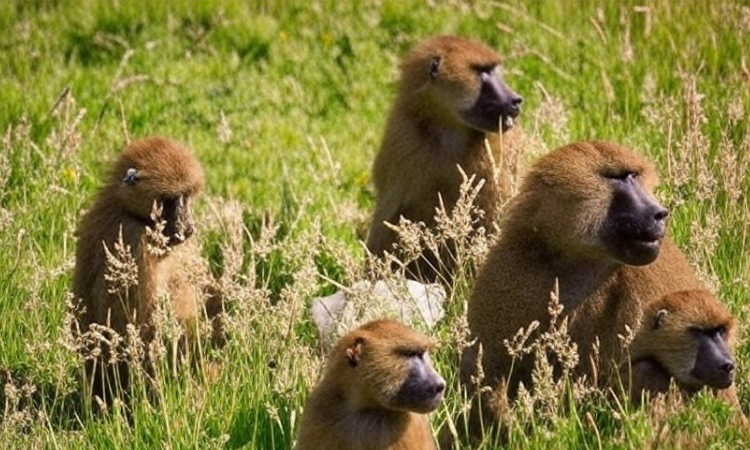
Physical Characteristics of a Baboon
These primates are built for endurance: robust bodies with long limbs for quadrupedal locomotion, powerful jaws for grinding tough vegetation, and sharp canines for defense and display.
Physical Appearance:
Baboons have a dog-like muzzle, prominent brow ridges, and close-set eyes, giving them a distinctive facial profile. Their fur varies by species: olives have greenish-gray coats, yellow sport yellowish-brown fur, chacma baboons display grayish-brown hues, while hamadryas have silvery-gray fur with striking pinkish-red facial skin in males.
Guinea and Kinda tend to have darker, reddish-brown coats. All species have hairless, calloused buttocks (ischial callosities) that are brightly colored in some, like the hamadryas, aiding social signaling.
Baboon Weight:
The weight of these species differs significantly by species and sex. Males are generally heavier, ranging from 20 to 40 kg (44–88 lbs), with chacma males reaching up to 45 kg (100 lbs).
Females are smaller, typically weighing 10–20 kg (22–44 lbs). Kinda baboons are the smallest, with males around 15–20 kg, while chacma baboons are the largest.
Size and Height of a Baboon:
These primates measure 50–115 cm (20–45 inches) in body length, excluding the tail, which adds 30–80 cm (12–31 inches). Standing height varies, but on all fours, they typically reach 50–70 cm (20–28 inches) at the shoulder.
When upright, larger males (e.g., chacma) can stand up to 1.2 m (4 ft). Males are notably larger than females across all species.
They feature powerful limbs, with longer hind legs for terrestrial movement, and their canines, especially in males, are large and sharp for defense and dominance displays.
Their robust physique and varied coloration make them highly adaptable to diverse habitats, from savannas to forests.
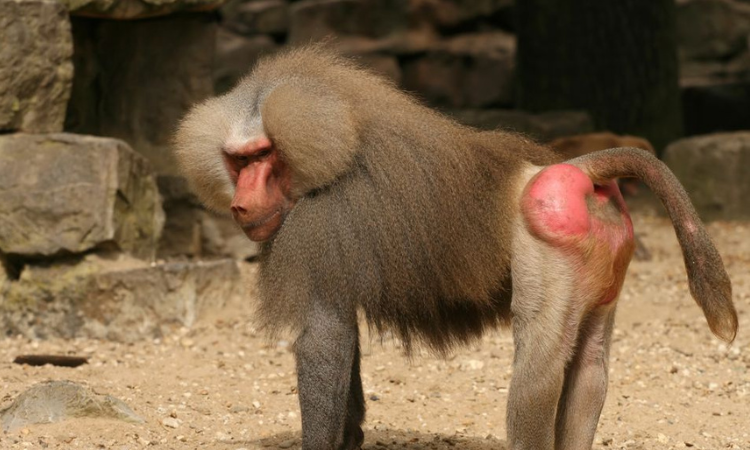
Baboon Buttocks
Baboon buttocks, known as ischial callosities, are hairless, brightly colored pads on the hindquarters of all six species. These baboon physical traits are most vivid in males, especially hamadryas, displaying striking red or pink hues.
The baboon butt serves social functions, signaling sexual receptivity in females during estrus and dominance or health in males.
Cushioning the buttocks for sitting, these callosities enhance baboon social communication, making them a key feature in troop interactions and mating displays.
Baboon Habitat and Distribution
Baboons epitomize ecological opportunism, inhabiting everything from semi-deserts to Afroalpine grasslands above 9,800 feet (3,000 m). They’re absent from rainforests but dominate open habitats where visibility aids predator detection.
The olive baboon range spans 25 countries in equatorial Africa, from Senegal to Kenya, thriving in gallery forests, thorny scrub, and savannas. Chacmas claim southern Africa south of the Zambezi, including deserts and mountains, surviving waterless for up to 11 days.
Yellow ones favor East African steppes and woodlands, while Guinea baboons hug West African forests and grasslands. Kinda baboons stick to central miombo woodlands, and hamadryas roam arid Horn of Africa cliffs and Arabian Sarawat Mountains, even extinct in ancient Egypt but persisting in Yemen and Saudi Arabia.
Daily ranges cover 2–10 miles, influenced by food and water. They roost in trees or cliffs at night, descending at dawn.
Climate change fragments these habitats, forcing troops into urban fringes. Olive baboons in Nairobi slums are seen scavenging trash, a stark adaptation to anthropogenic pressures.
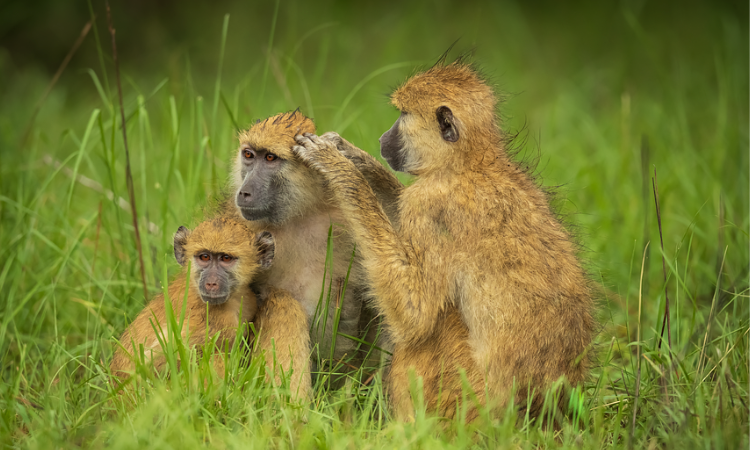
Baboon Behavior and Social Structure
Baboons, from six Papio species, showcase intricate baboon behavior and dynamic social structure, captivating researchers studying primate social systems.
Living in troops of 20–100+, they form complex baboon social hierarchies led by dominant males who establish rank through displays, fights, or alliances. Females anchor the troop with matrilineal bonds, shaping baboon group dynamics and stability.
Baboon social behavior centers on grooming, which strengthens relationships and reduces conflict within the baboon troop.
Males compete fiercely for mating rights, with dominant individuals prioritized, though female choice influences baboon mating behavior.
Communication is robust, using vocalizations (barks, screams), facial expressions, and postures to convey status or warnings. Their aggression, especially among males, occurs during dominance disputes, but reconciliation through grooming maintains harmony.
Species like hamadryas form harem-based units, while olive and yellow live in multi-male, multi-female groups, highlighting diverse social organization.
Cooperative foraging, predator defense, and shared parenting reflect their adaptability across African savannas and forests.
Baboon intelligence enables problem-solving and strategic social navigation, making their primate social structure a key focus for studies on evolution and sociality, engaging wildlife enthusiasts searching for insights into baboon troop behavior.
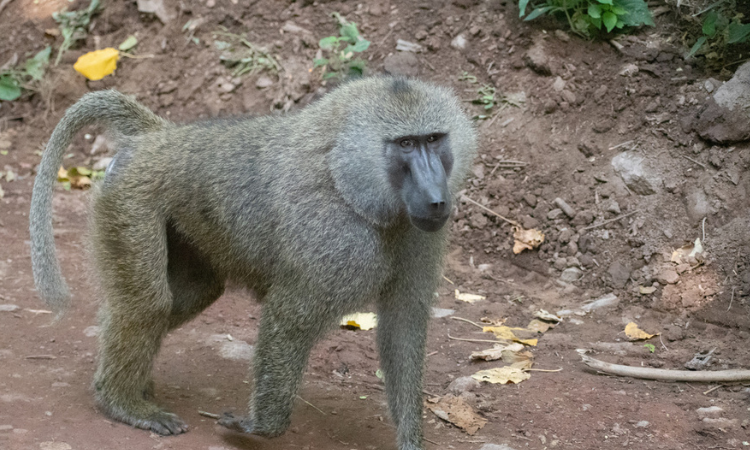
How do Baboons Communicate?
They communicate through a rich mix of vocalizations, facial expressions, body postures, and tactile behaviors. Common vocalizations include barks, grunts, screams, and wahoos to signal alarm, aggression, or contact.
Facial expressions, like baring canines or eyebrow raises, convey dominance or submission. Grooming strengthens social bonds, while postures such as presenting or staring assert status.
Each species, like hamadryas or olive, uses these methods to navigate their complex social hierarchies, ensuring effective group coordination and conflict resolution.
Reproduction and Lifespan
Baboon reproduction is a key aspect of their life history, shaped by complex baboon mating systems. Female baboons reach sexual maturity around 4–6 years, displaying baboon estrus cycles with visible sexual swellings to attract males.
Dominant males often secure mating opportunities, but female choice influences baboon mating behavior. Gestation lasts about 6 months, resulting in a single infant.
Baboon parental care is primarily maternal, with females nursing and protecting offspring for up to a year. Infants depend on mothers for survival, learning social skills within the troop. Baboon life cycle includes juvenile and adolescent stages, with males dispersing to new troops.
What do baboons eat: Diet and Foraging Habits
Baboons, omnivores extraordinaire, exhibit a versatile baboon diet, consuming over 200 food types that shift seasonally.
Baboon food sources include grasses (up to 50% in dry seasons), fruits, seeds, pods, leaves, roots, bark, and tubers, supplemented by insects (termites via “fishing”), small vertebrates (rodents, hares, fledglings), and scavenged meat.
Chacmas hunt vervet monkeys or antelope fawns, even foraging marine algae in coastal areas, while Kinda baboons prioritize fruits (70% of their dietary habits).
Their foraging habits are gregarious, with troops traversing vast areas. Scouts lead, using alarm calls to signal dangers. Baboon foraging behavior utilizes cheek pouches to store food, with hindgut fermentation extracting 60–80% of nutrients.
They raid crops like maize and bananas, sparking human-wildlife conflict. In arid zones, they survive on low-quality forage, with chacmas relying on metabolic water for dehydration resilience.
Studying baboon eating habits and primate feeding behavior highlights their ecological adaptability, engaging wildlife enthusiasts and researchers.
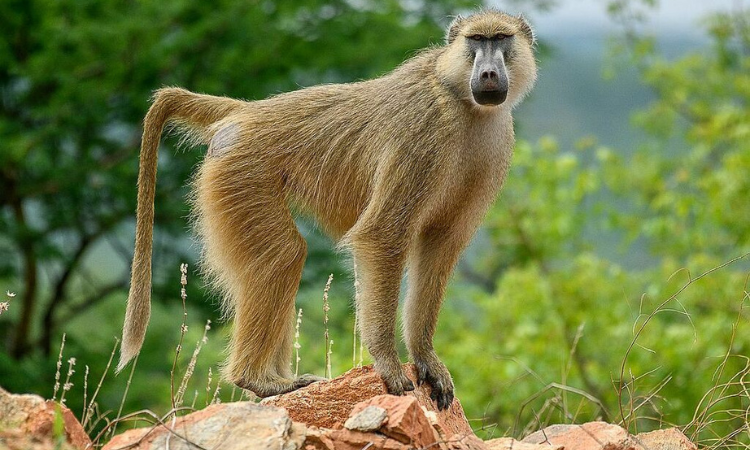
Baboon Predators
Baboons face numerous predators in their African habitats. Leopards are primary threats, ambushing them at night or in dense vegetation.
Lions and hyenas also prey on baboons, targeting juveniles or isolated individuals. Nile crocodiles pose risks near water sources, while large eagles, like martial eagles, snatch infants. Pythons occasionally attack smaller ones.
Baboon defense mechanisms include group vigilance, alarm calls, and aggressive mobbing by males, leveraging their sharp canines to deter predators, ensuring troop survival.
What is the conservation status of baboons?
Most baboon species are classified as Least Concern on the IUCN Red List, reflecting stable populations across their African habitats. These include olive, yellow, chacma, hamadryas, and Kinda baboons, which adapt well to diverse environments.
However, the Guinea baboon is Near Threatened due to baboon habitat loss, hunting, and human-wildlife conflict. Baboon conservation efforts focus on mitigating deforestation and crop-raiding disputes to ensure their survival, preserving these resilient primates for future study and ecological balance
How do baboons interact with humans?
They interact with humans in varied ways, often shaped by habitat overlap. Baboon-human conflict arises when they raid crops like maize or bananas, earning them a baboon pest reputation in agricultural areas.
They may act aggressively if threatened or approached. However, baboons can tolerate human presence in tourist areas or reserves.
Baboon management strategies include monitoring, non-lethal deterrents like fences, and community education to reduce conflict, promoting coexistence while protecting crops and ensuring safety.
What role do baboons play in their ecosystems?
Baboons play vital roles in their ecosystems as omnivores. Their baboon ecological impact includes seed dispersal, spreading plant seeds through their diverse baboon diet of fruits and seeds, promoting forest regeneration.
By consuming insects, they help control pest populations, benefiting local flora. Baboon foraging habits shape vegetation structure, as their grazing and digging influence grasslands and savannas.
Their ecological roles enhance biodiversity, making them key players in maintaining healthy ecosystems across their African habitats.
What are the threats to baboon populations?
These primates face significant baboon population threats from habitat loss due to agricultural expansion and urbanization, reducing their natural ranges.
Human-wildlife conflict escalates as they raid crops, leading to retaliatory killings. Hunting for meat or pest control further endangers them, particularly Guinea baboons.
Baboon conservation efforts focus on habitat protection, creating buffer zones, and implementing non-lethal deterrents like fencing to mitigate conflicts, ensuring sustainable coexistence and preserving baboon populations for ecological balance.
How do baboon personalities affect their behavior?
Baboon personalities significantly influence their behavior, particularly in social contexts. Bold ones often lead foraging or confront predators, enhancing troop survival through baboon social learning.
Anxious individuals may be more cautious, avoiding risks but potentially missing opportunities. Studies show boldness drives exploration and innovation in feeding strategies, while anxiety can limit social interactions.
These baboon behavioral traits shape troop dynamics, with bold leaders fostering cooperation and anxious members relying on group vigilance, impacting overall primate social behavior.
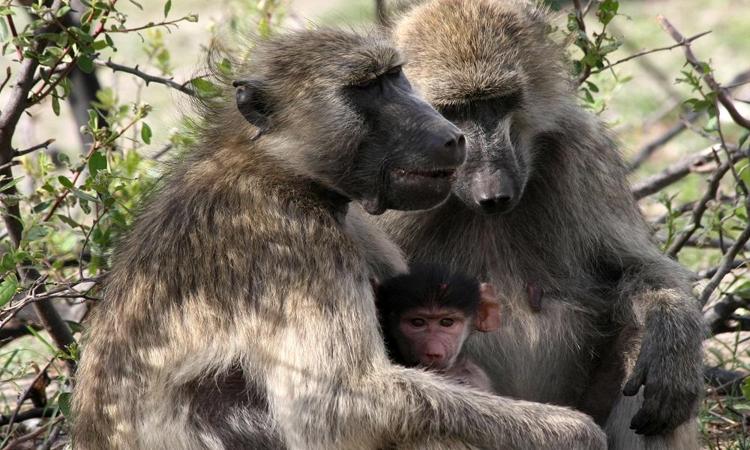
Fun Facts About Baboons
- social skills: They live in troops of up to 100, with complex hierarchies led by dominant males and matrilineal female groups.
- Baboon diet variety: As omnivores, they eat over 200 food types, from fruits to small mammals, adapting to seasonal changes.
- Baboon communication: They use barks, grunts, and facial expressions, like canine baring, to signal emotions and status.
- Baboon buttocks: Their colorful, hairless ischial callosities signal mating readiness and dominance.
- Baboon intelligence: They solve problems and learn socially, with bold personalities driving innovation in foraging.
Best Places to See Baboons in Africa
The premier spot to observe chacmas is Cape Point Nature Reserve in South Africa’s Table Mountain National Park.
Here, troops roam freely along coastal trails, offering close-up views of their social antics amid stunning ocean and mountain scenery.
For olives, head to Serengeti National Park in Tanzania, where large groups forage on savannas during game drives.
In Ethiopia’s Simien Mountains, spot hamadryas in dramatic highlands. These accessible sites highlight their behaviors while minimizing human-wildlife conflict.
